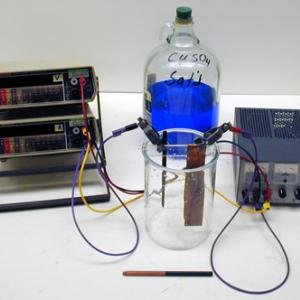College of Liberal Arts & Sciences
5E30.20 - Electroplating Copper
Pour the saturated copper sulfate solution into the battery jar so that it covers a good portion of the suspended electrodes. Insert the electrodes suspended from the Plexiglas rod and connect them to the power supply as shown. The resistor is inserted between the positive and negative outputs of the power supply to prevent shorting . Turn on the power supply and apply the desired voltage. The carbon electrode will become coated with copper in a short time.
- Deborah F. Buffum, "Carbon Electrodes Improvised", TPT, Vol. 35, # 5, p. 315, May 1997.
- Arun C. Venkatachar, "Determination of the Electronic Charge - Electrolysis of Water Method", TPT, Vol. 23, # 6, Sept. 1985, p. 365.
- Ef-4: Freier and Anderson, A Demonstration Handbook for Physics.
- Bassam Z. Shakhashiri, "11.23 - Copper Leaves: Electroplating with Copper", Chemical Demonstrations, Vol. 4, p. 212.
- Bassam Z. Shakhashiri, "11.24 - Forming a Copper Mirror", Chemical Demonstrations, Vol. 4, p. 224.
- Bassam Z. Shakhashiri, "11.25 - Nickel Plating; Shiny Nickel Leaves", Chemical Demonstrations, Vol. 4, p. 228.
- Bassam Z. Shakhashiri, "11.26 - Chromium Plating", Chemical Demonstrations, Vol. 4, p. 232.
- Bassam Z. Shakhashiri, "11.27 - Silver Plating", Chemical Demonstrations, Vol. 4, p. 236.
- Bassam Z. Shakhashiri, "11.29 - Galvanizing: Zinc Plating", Chemical Demonstrations, Vol. 4, p. 244.
- Joseph H. Adams, "Galvanism and Electro-Plating", Harper's Electricity Book For Boys", p. 266.
- Theodore Gray, "Titanium in Technicolor", Popular Science, Aug. 2005, p. 94 - 95.
- Sarah Hansen, "Electroplating", Popular Mechanics, May 2013, p. 114.
- Joey Green, "Copper Nail", The Mad Scientist Handbook, Vol. 1, p. 11.
- Grant Mellor, "Chlorine from a Drop", Flying Tinsel, 1993, p. 73-76.
- W. Bolton, "Electrolysis (1)", Book 4 - Electricity, Physics Experiments and Projects, 1968, p. 13-15.
- W. Bolton, "Electrolysis (2)", Book 4 - Electricity, Physics Experiments and Projects, 1968, p. 15-17.
- Rudolf F. Graf, "Electrochemistry", Safe and Simple Electrical Experiments, p. 80.
- Prof. Robert Griffith, "Electro-Plating", Boys' Useful Pastimes, p. 312.
Disclaimer: These demonstrations are provided only for illustrative use by persons affiliated with The University of Iowa and only under the direction of a trained instructor or physicist. The University of Iowa is not responsible for demonstrations performed by those using their own equipment or who choose to use this reference material for their own purpose. The demonstrations included here are within the public domain and can be found in materials contained in libraries, bookstores, and through electronic sources. Performing all or any portion of any of these demonstrations, with or without revisions not depicted here entails inherent risks. These risks include, without limitation, bodily injury (and possibly death), including risks to health that may be temporary or permanent and that may exacerbate a pre-existing medical condition; and property loss or damage. Anyone performing any part of these demonstrations, even with revisions, knowingly and voluntarily assumes all risks associated with them.
